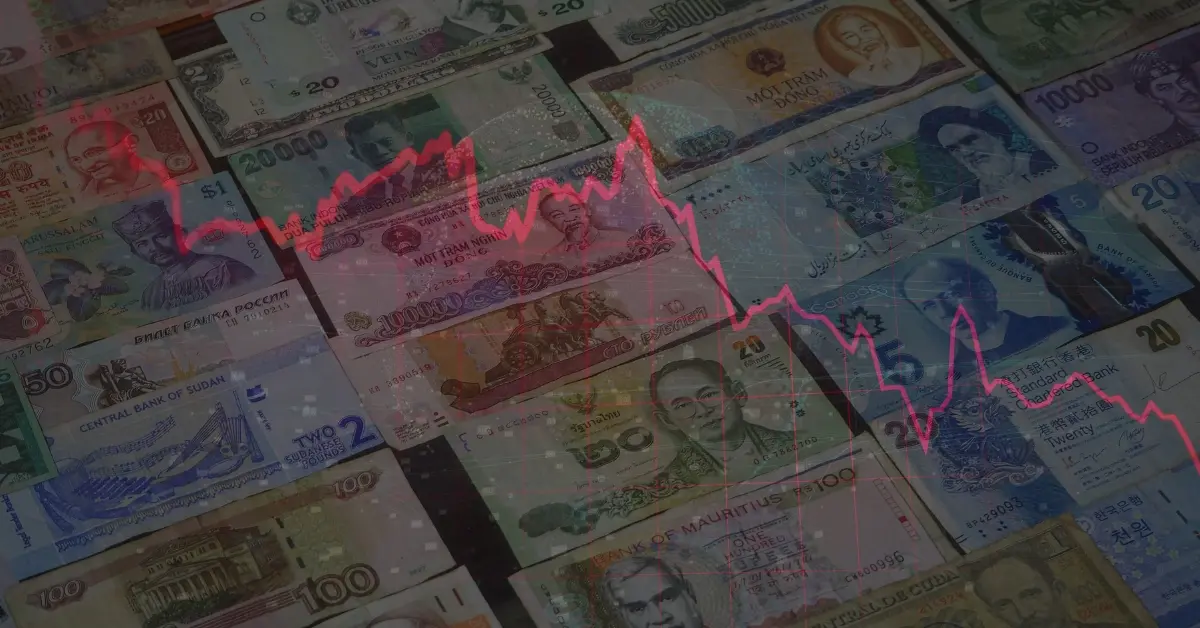A particular currency will always be worth more than the other. That’s simply an economic fact.
But people are always curious about the strongest and most stable currencies. How about the world’s weakest currencies?
In this article, we’ll examine the top 10 cheapest currencies in the world as of 2024. These currencies may be unattractive to investors due to the absence of demand, but they should never be overlooked.
Read on and explore why these currencies are at the bottom of the currency market.
The 10 Weakest Currencies in the World [2024]
When you think of currency aside from your own, the US dollar pops into your mind. That’s because the American dollar is the most popular currency – it’s even called the global currency.
But what about the currencies you rarely think of—or may not even know exist? These are the ones with minimal demand and the lowest value globally.
Let us look at the lowest currencies in the world and the reasons behind their slumped value.
#10 – Colombian Peso (COP)
| 1 USD | 4,340.28 COP |
| 1 COP | 0.00023 USD |
The Colombian Peso (COP) is the official currency of Colombia, a country rich in natural resources, specifically petroleum, coal, and crude oil.
However, its wealth in natural resources doesn’t translate into the wealth of its economy.
In 2021, the country was hailed as the largest coal producer in Latin America. It’s also rich in petroleum and other liquids, ranking second after Brazil.
Crude oil is also the primary driver of Colombia’s gross domestic product (GDP). According to the latest US Energy Information Administration data, America’s fifth-largest crude oil imports are from Colombia.
These commodities have skyrocketed in recent years, with crude oil being recognized as black gold due to its almost intrinsic value.
However, the COP resists following suit. This is because of the country’s internal struggles.
- Political Unrest. The Peso started plummeting in 2022 following the victory of President Petro. With his reform agenda, the currency has lost a fifth of its value due to uncertainty.
- Major Currencies Rate Hike. The rate hike by the US also made the COP less attractive to foreign investors.
- Russia-Ukraine Conflict. The geopolitical tension between Russia and Ukraine has stabilized the decline of Peso.
#9 – Cambodian Riel (KHR)
| 1 USD | 4,032.26 KHR |
| 1 KHR | 0.00025 USD |
The Colombian Riel (KHR) is Colombia’s official currency.
For decades, the Cambodian economy has relied heavily on the US dollar. It’s so dollarized that citizens and tourists are more comfortable transacting in USD than their own currency.
Additionally, most tourist-oriented businesses quote their products and services in dollars.
This reliance on the US dollar has hindered Riel’s broader adoption and value growth.
However, the Cambodian government has started the country’s de-dollarization campaign. The reason is obvious – to boost the usage and value of riel, thus, the “rielization.”
Chea Serey, National Bank of Cambodia governor, said de-dollarization and rielization are essential for economic growth and KHR price stability. This is because widespread use of riel could enhance the effectiveness of conducting monetary policy.”
#8 – Paraguayan Guarani (PYG)
Paraguayan Guarani (PYG) is the official currency of Paraguay. It is the eighth-lowest currency in the world and the weakest among all currencies in America.
Paraguay has significant hydroelectric power, with Itaipu dam producing the world’s largest hydroelectric power output.
However, the country has yet to see any improvement in foreign investments that could boost PYG’s valuation. The currency still bears the impact of its historical monetary issues.
During the 1980s and 1990s, several printing companies printed the PYG banknotes and circulated them publicly. Additionally, some 2005 PYG banknotes became publicly available before their supposed release.
Thus, the Banco Central del Paraguay declared all 2005 currencies void and useless.
#7 – Guinean Franc (GNF)
Guinean Franc is the official currency of Guinea, a country that heavily relies on its mining sector for its economic valuation.
A sub-country in South Africa, Guinea is rich in natural resources, especially gold and diamonds. However, the intrinsic value of gold is still insufficient to recover the depreciating GNF.
The reasons behind GNF’s persistent decline are the galloping inflation rate, political unrest, and its overreliance on the mining sector. According to the Internation Monetary Fund (IMF), such factors keep the economic activity of the Guinean franc below potential.
#6 – Uzbekistani Sum
| 1 USD | 12,931.59 SOM |
| 1 SOM | 0.000077 USD |
Uzbekistani Sum is the official currency of Uzbekistan.
When the sum was first introduced in 1994, one USD could be exchanged for seven sums. Today, the dollar’s advantage over the sum has increased 1,847 times.
This rapid two-decade decline in sum devaluation was due to the country’s inflation hike and the country’s de-dollarization. The country’s ambitious reform triggered the wave of devaluation.
In 2017, the soum was de-pegged from the USD. This change in monetary policy resulted in the sharp decline of the currency.
And the currency appreciation of its major trading partners. In the end of 2021, the ruble was appreciating against USD due to the impending recession.
Additionally, Turkish lira has depreciated by 97% over the past year. But this didn’t push the sum to appreciate.
#5 – Indonesian Rupiah (IDR)
| 1 USD | 15,931 IDR |
| 1 IDR | 0.000063 USD |
Indonesian Rupiah is the official currency of Republic of Indonesia – the world’s fifth and Asia’s fourth weakest currency.
The impact of the COVID-19 pandemic was the primary reason behind Rupiah’s decline.
#4 – Laotian Kip
| 1 USD | 22,197 KIP |
| 1 KIP | 0.000046 USD |
Landlocked in Southeast Asia, Laos owns the fourth weakest currency in the world.
The continued depreciation of the kip is mainly due to the heightened inflation rate and increasing foreign debts. The country suffers from slowing economic growth.
When the country relies too much on imported goods, currency devaluation is inevitable. This is because the government would rather rely on foreign products than boost its local production capacity.
But that doesn’t mean Laos are exporting anything to the global market. In fact, the country’s GDP mainly consists of agricultural exports – it exceeds for about a billion USD from the 2024 target.
However, this agricultural export remains insufficient to balance the imports and exports of the country.
#3 – Sierra Leonean Leone
| 1 USD | 22,883 SLL |
| 1 SLL | 0.000044 USD |
Sierra Leone is another resource-rich nation with a struggling currency. Leone has been battered by years of civil war, an Ebola epidemic, and governance challenges.
- Economic Instability: Years of conflict have left a fragile economic framework.
- Debt and Inflation: High levels of debt and rising inflation contribute to the leone’s depreciation.
- Resource Mismanagement: Despite rich diamond reserves, corruption, and poor governance prevent equitable growth.
#2 – Vietnamese Dong
| 1 USD | 25,394 VND |
| 1 VND | 0.000039 USD |
Vietnamese dong is the official currency of Vietnam, a country that was once the world’s poorest.
A struggle that dates back to the 1980s, the primary driver behind the long decline of the dong is the country’s poverty.
Its inflation has risen to 400%, making it impossible for Vietnamese to access even the most basic consumer goods. Additionally, cities are regularly darkened by power outages—a struggle it shares with South Africa.
Citizens become dependent on external aid, primarily from the Asian Development Bank, the World Bank, and the International Monetary Fund. With assistance from the International Monetary Fund, the country improved public administration, tax policy, central banking, and statistical gathering to measure and assess Vietnam’s economic growth.
These efforts are integral to Vietnam’s status as the world’s poorest country. However, the Vietnamese government, specifically the State Bank of Vietnam (SBV), has yet to address its declining currency.
#1 – Iranian Rial (IRR)
| 1 USD | 42,016.81 IRR |
| 1 IRR | 0.000024 USD |
Mismanagement from the government, heightened sanctions from regulators and global economies, economic isolation, and recession.
That’s Iran economy in a nutshell – and the reason why the Iranian Rial has been free falling for three years now. This free fall made IRR the weakest currency in the world.
Iran has been warned by global leaders about their nuclear program. However, the government shrug resulted in various sanctions and even economic isolation.
Economic isolation occurs when global economies deliberately steer away from investing in isolated economies. In the case of Iran, the isolation was driven not only by international sanctions but also by xenophobia.
The IRR health remains devastated despite the oil price hike – the country’s main export. Why?
Iran President Ahmadinejad has been exerting inflationary pressure. Since his presidential election, the country’s inflation has been in two digits, even hitting 40% once.
This significant inflation hike was caused by the extremely lax monetary policy of the Central Bank of Iran.
Moreover, the world’s largest economies imposed sanctions on Iran mainly because of the country’s human rights violations and its nuclear project. The United States, the European Union, the United Nations, Canada, and Australia are among them.
What Makes a Currency Weak?
At its core, weak currencies are those of nations that are constantly in decline. In other words, these currencies have relatively lower value compared to other global currencies.
Remember the keyword – constantly in decline.
A decline in the currency’s exchange rate is normal as the market fluctuates extremely. However, a long, stretched decline is what constitutes the weakness status of the currency.
There are numerous reasons behind the currency’s constant decline. However, the major indicator is the country’s inflation rate.
Inflation Rate Matters
A high inflation rate signifies a corroding purchasing power of the people using the currency. Simply mean, you use the same amount of money to buy fewer goods and services.
A high inflation rate, by itself, doesn’t necessarily mean a loss of investors’ confidence. Rather, it’s an uncontrollable inflation hike that made investors uncertain about the currency’s value over time.
Trade Imbalances Create Deficiency in Demand
Aside from the inflation rate, trade imbalances are also significant to the devaluation of currencies.
Why? Imagine it like this – a country with high imports and low exports will deal with more foreign currencies than its own. This deficiency causes the dried-up demand, putting downward pressure on the currency’s value.
Thus, a country with a low import-export ratio will likely experience currency depreciation. And an extended trade imbalance would likely weaken the overall currency valuation.
Is a Weak Currency a Bad Thing?
A weak currency is not inherently bad – the same goes for the goodness of strong currencies.
This is because a low-valued currency impacts the country’s trade balance. When the currency weakens, importing goods becomes more expensive than usual. This is because more currencies are needed to purchase international or foreign goods.
Conversely, a weakening currency could help the country’s exports become globally competitive. These goods and products made with weak currencies are generally cheaper for foreign buyers.
This export advantage of the weakening currency was evident in the 2016 Yuan Depreciation.
Can You Trade Weak Currencies in the Forex Market?
Hypothetically, any currency can be traded in the derivative forex market. However, there is little to no demand from foreign investors, making it illiquid.
Note: When the market is illiquid, an asset is difficult to buy or sell. Investors perceive an illiquid asset as an inviable financial asset.
While all currencies can be theoretically traded, only around 130 currency pairs (70 currencies) are listed among most forex brokers. This is because traders are not interested in these currencies.

















